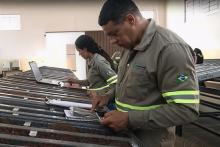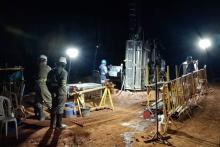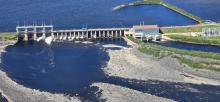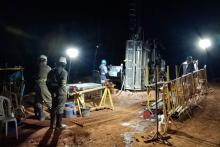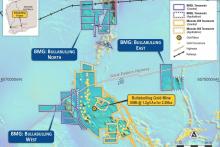St George Mining has launched a new drilling mission designed to better define the rare earths footprint at its Destiny project in WA’s Eastern Goldfields, where it has previously jagged up to 5125ppm TREO. Maiden drilling results at Destiny showed rare earths mineralisation in near-surface clay zones up to 42m thick throughout a 7km-long zone that remains open in all directions.


St George Mining has launched a new drilling mission designed to better define the rare earths footprint at its Destiny project in Western Australia’s Eastern Goldfields region, where it has previously jagged up to 5125 parts per million total rare earth oxides (TREO).
The company reported early last December that its maiden drilling results at Destiny showed rare earths mineralisation in near-surface clay zones up to 42m thick throughout a 7km-long zone that remains open in all directions. Significantly, anomalous rare earths mineralisation above 100ppm TREO was logged in all 61 holes drilled, at depths between 2m and 98m.
Notable results from the initial program include one hole which bored through 30m at 1885ppm TREO with 399ppm magnet rare earth oxides (MREO) from 20m, including 6m going 3578ppm TREO with 755ppm MREO from 32m and also featuring 2m running at a program-topping 5125ppm TREO with 1199ppm MREO from 32m.
A second hole intercepted 8m at 1673ppm TREO with 342ppm from 24m.
Two other separate notable intercepts included 42m going 1832ppm TREO with 351ppm MREO from 12m, including 14m at 2622ppm TREO and 515ppm MREO from 38m and 29m at a grade of 1042ppm TREO with 200ppm MREO from 14m.
St George Mining executive chairman John Prineas said: “The potential scale of Destiny is impressive, with mineralisation already confirmed along a 7km stretch of the Ida Fault zone and a further 70km of prospective geology yet to be drilled. Mineralisation contains a high proportion of magnetic rare earths adding to the attractiveness of the Project.”
Management says less than 10 per cent of the target area has been comprehensively tested. And because the mineralisation in the high-grade intervals appears to be largely homogenous, St George has concluded there exists sound potential for additional and consistent mineralisation across the clay zone.
Accordingly, its current follow-up drilling is designed to confirm mineralisation continuity and it will also provide metallurgical samples. At least 26 air-core (AC) holes are planned for more than 1000m of drilling, with assays expected within about six weeks from completion of the work.
Recently-completed work includes a geochemical auger drill soil sampling program that probed beneath shallow surface cover in a bid to sniff out any underlying rare earths or lithium signatures hiding under an area of 50 square kilometres and which could expand the known mineralisation at the project. The program comprised 735 samples collected on a grid of 800m by 100m.
Shallow augur is a handy tool as it is fast, light and relatively cheap and as long as sample contamination can be kept to a minimum, it is a useful way of getting below possible dilution and contamination from recent wind-blown sands and other humic matter.
The company also undertook an airborne magnetic survey and identified several circular magnetic features with diameters up to 2.5km. It has interpreted them as possible late-stage intrusive bodies, potentially carbonatites, which have become increasingly sought-after because of their association with both rare earths and lithium.
St George has noted that some of the magnetic signatures lie close to or along strike from rare earths-mineralised clay zones at Destiny and is naturally musing on the possibility of them being the primary rare earths sources. Additionally, some of them are seen to be close to the major Ida Fault and its significant splay faults that could also be a conduit for the potentially mineralised intrusives.
Neither possibility has been tested, leaving St George with good potential to get ahead of the field in the area.
The company has made a good start by taking the first step and planning several local gravity surveys across each of the circular targets to test for density differences that could highlight carbonatites or similar alkaline intrusive features known to carry rare earths and lithium.
One look at Venture Minerals’ eye-watering results across its 40-square-kilometre Jupiter target, 80km south-west of Mt Magnet in WA’s Mid-West, is sufficient to tell anyone there are no flies on that theory.
St George was last month granted a further 200sq km of ground to the southern extremity of its current tenure. The new ground straddles a 20km stretch of the Ida Fault, adding to its already significant coverage of or proximity to the massive structure that transects much of the Eastern Goldfields geology, from the coast south of Norseman to Wiluna and potentially as far as the Marymia Inlier.
The Destiny project covers an extensive area centred about 100km south-west of Kambalda and a similar distance and direction from Mineral Resources’ Mt Marion operation.
St. George is in a dominant tenement situation in an increasingly hot area for multiple commodities and it not only has plenty of ground to work on but is also getting plenty of good encouragement from its exploration results to date.
In heraldry, the Saint George's Cross is a red cross on a white background, which from the Late Middle Ages became associated with Saint George – the military saint, who was often depicted as a crusader.
That description might well soon also apply to the company’s “destiny” as a first mover in the Eastern Goldfields?
Is your ASX-listed company doing something interesting? Contact: matt.birney@businessnews.com.au





